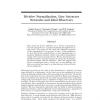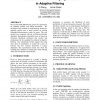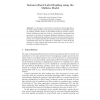JMLR
2008
14 years 5 months ago
2008
The statistical perspective on boosting algorithms focuses on optimization, drawing parallels with maximum likelihood estimation for logistic regression. In this paper we present ...
CSDA
2007
14 years 5 months ago
2007
Many probabilistic models are only defined up to a normalization constant. This makes maximum likelihood estimation of the model parameters very difficult. Typically, one then h...
IPM
2008
14 years 5 months ago
2008
Language modeling is an effective and theoretically attractive probabilistic framework for text information retrieval. The basic idea of this approach is to estimate a language mo...
NIPS
1998
14 years 7 months ago
1998
Gain control by divisive inhibition, a.k.a. divisive normalization, has been proposed to be a general mechanism throughout the visual cortex. We explore in this study the statisti...
TREC
2001
14 years 7 months ago
2001
We used the YFILTER filtering system for experiments on updating profiles and setting thresholds. We developed a new method of using language models for updating profiles that is ...
EMNLP
2004
14 years 7 months ago
2004
We compare and contrast two different models for detecting sentence-like units in continuous speech. The first approach uses hidden Markov sequence models based on N-grams and max...
AAAI
2006
14 years 7 months ago
2006
Object detection using Haar-like features is formulated as a maximum likelihood estimation. Object features are described by an arbitrary Bayesian Network (BN) of Haar-like featur...
NIPS
2007
14 years 7 months ago
2007
Clustering is often formulated as the maximum likelihood estimation of a mixture model that explains the data. The EM algorithm widely used to solve the resulting optimization pro...
NIPS
2007
14 years 7 months ago
2007
The expectation maximization (EM) algorithm is a widely used maximum likelihood estimation procedure for statistical models when the values of some of the variables in the model a...
EWCBR
2008
Springer
14 years 7 months ago
2008
Springer
In this paper, we introduce a new instance-based approach to the label ranking problem. This approach is based on a probability model on rankings which is known as the Mallows mode...



